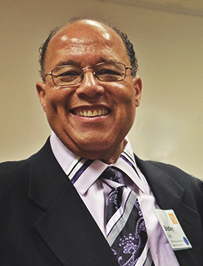• by Bradley Scott, Ph.D. • IDRA Newsletter • May 2014 •
As of May 17, it will be 60 years since the U.S. Supreme Court rendered its historic 9 to 0 decision that “separate educational facilities are inherently unequal.” Sixty years later, the real question may be: How far have we come and how far must we go to fulfill the promise of Brown? It was just 10 years ago that IDRA was helping to commemorate the 50th anniversary of the Brown vs. Board of Education of Topeka, Kansas U.S. Supreme Court decision.
Ten years ago, IDRA played a role in three important ways regarding the commemoration of the Brown decision. First, IDRA was asked by the Brown vs. Board of Education 50th Anniversary Commission, created by the U.S. President and Congress, to co-sponsor a dialogue across sectors and across race to discuss the implications of the Brown decision on Latino Americans. IDRA conducted this dialogue event in San Antonio in which the question posed above essentially served as the backdrop for conversations about the application of the decision to the quality of education Latino students receive in public schools. The Mendez vs. Westminster appellate case connected the experience of Latino American students directly to the Brown case. But more importantly, it expanded the historic conversation to a more diverse application and context of students across the United States. Highlights of the event are on our Fullfilling the Promise of Brown and Mendez website.
Second, IDRA seized the opportunity to follow that event with a series of cross-sector, cross-race conversations in Alabama, Arkansas, Louisiana, New Mexico, Mississippi, Oklahoma and Texas. These dialogues were designed to assist stakeholders in talking with each other about local plans of action to, as a part of their commitment to fulfill the promise of Brown, support African American students and Latino students in public schools, including their graduation from high school and college going. These dialogues challenged local people to examine the barrier and facilitating forces in their own community and the local education system that impacts educational success for Black and Brown students.
Third, IDRA created a set of materials that other communities can use to replicate the conversations and create local plans to transform schools into engines of success and college going for African American students and Latino students across the nation. The most comprehensive is Creating Your Education Blueprint for Action – Mendez and Brown Community Dialogues – A Launch Kit, which is available from IDRA and free online.
Dr. María “Cuca” Robledo Montecel, IDRA’s President & CEO, made comments about the Brown decision during the initial Latino Pursuit of Excellence and Equity dialogue event in 2003 that still stand today:
“Almost 50 years later, the promise of Brown remains unmet. In fact, the promise of Brown may be slipping further out of reach.
“According to the Harvard Civil Rights Project, public schools in the United States are re-segregating. As we began the new millennium, 40 percent of Black students attended schools that were 90 percent to 100 percent Black. This is up from 32 percent in 1988. In nine out of 10 of these schools the majority of children were poor. This is not the promise of Brown.
“Latino children are the most segregated, and they attend the poorest schools. They receive the poorest preparation by the least trained teachers and have little access to rigorous curriculum that would prepare them for college. This is not the promise of Brown.
“Seventy-five percent of the 4.5 million students who speak a language other than English have a seat in the classroom but are left out of the class because of English-only policies that are concerned with politics instead of learning (Kindler, 2002). This is not the promise of Brown, of Mendez, of Lau or of Plylar. This is not the promise we have made to children.
“So, how do we make good on this promise? It seems to me that we must secure three foundations: We must keep the public in public education, we must press for accountable schools, and we must fund schools for the common good.”
The U.S. President, the Secretary of Education and the Assistant Secretary for the Office for Civil Rights have presented to the nation the latest update of the Civil Rights Data Collection (CDRC). When one examines various education snapshots about the condition of education across the nation, based upon the self-report of all districts and schools in the United States, one can see that Dr. Robledo Montecel’s observation about the unmet promise of Brown still rings true for far too many of learners across race, gender and national origin, including language, citizenship status and economic level. The CDRC provides many snapshots of findings about public education in the United States. An example of one snapshot focusing on college and career readiness with explanations taken from the CDRC shows the following.
- Limited access to high-level math and science courses: Nationwide, only 50 percent of high schools offer calculus, and only 63 percent offer physics.
- Significant lack of access to other core courses: Nationwide, between 10 percent and 25 percent of high schools do not offer more than one of the core courses in the typical sequence of high school math and science education, such as Algebra I and II, geometry, biology and chemistry.
- Even less access for Black, Latino, American Indian and Alaska Native students: A quarter of high schools with the highest percentage of Black students and Latino students do not offer Algebra II, a third of these schools do not offer chemistry.
- Growing opportunity gap in gifted and talented education: Black students and Latino students continue to be disproportionately under-represented.
- Black students and Latino students continue to be disproportionately under-represented in Advanced Placement (AP) and dual credit courses.
- Disproportionately higher rates of retention continue for students of color, English learners and students with disabilities.
Snapshots about discipline, teacher quality, resource distribution and more also are available. These snapshots show the work that lays out a path of what we have yet to do. We have made so many changes over 60 years. We have been able to elevate so many people, so many generations, in so many ways. At one point, we were able to expand the middle class, move diverse people into the middle class, support college going and building platforms for life success for their daughters and sons. We cannot deny that some things have changed in 60 years. To do so would be dishonest.
What we cannot afford to do is to think that because some things have changed, everything is all right. Everything is not all right. We still have work to do. We cannot afford to take another 60 years to come to the reality that writing off generations of American citizens, regardless of their diverse characteristics, or relegating them to second and third class citizenship status is a viable road to keeping this nation strong, competitive and a leader in the world. We must be excellent in a 21st century world with all learners achieving at the highest levels. The fact remains, “We should not kid ourselves, excellence still requires (educational) equity” (2000). Happy Birthday to you, Brown decision.
Resources
Civil Rights Data Collection. Website (Washington, D.C.: U.S. Department of Education, nd).
Robledo Montecel, M. “Fulfilling the Promise of Brown vs. Board of Education,” IDRA Newsletter (San Antonio, Texas: Intercultural Development Research Association, November-December 2003).
Rodríguez, R.G., & A. Villarreal, J.D. Cortez, B. Scott. Creating Your Education Blueprint for Action – Mendez and Brown Community Dialogues – A Launch Kit (San Antonio, Texas: Intercultural Development Research Association, 2010).
Scott, B. “We Should Not Kid Ourselves: Excellence Requires Equity,” IDRA Newsletter (San Antonio, Texas: Intercultural Development Research Association, February 2000).
Bradley Scott, Ph.D., is a senior education associate in IDRA Field Services. Comments and question may be directed to him via email at feedback@idra.org.
[©2014, IDRA. This article originally appeared in the May 2014 IDRA Newsletter by the Intercultural Development Research Association. Permission to reproduce this article is granted provided the article is reprinted in its entirety and proper credit is given to IDRA and the author.]



